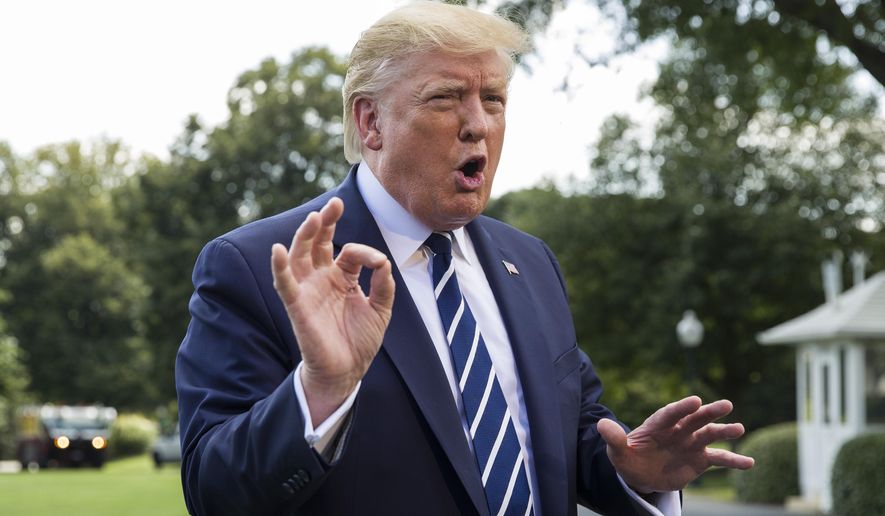WASHINGTON (AP) - Rather than tangle with a stronger U.S. military, Iran is poking and prodding its Western antagonists in ways apparently designed to avoid triggering war but that nonetheless seem to heighten the risk of missteps and miscalculation that could lead to an armed conflict with global consequences.
The tensions picked up Friday with Iran reporting it had seized a British-flagged oil tanker in the Persian Gulf , one day after the U.S. said it destroyed an Iranian drone that had flown within threatening range of an American warship in the Strait of Hormuz. In June the Iranians shot down a U.S. Navy drone in the same area, prompting President Donald Trump to authorize a military strike on Iran, only to call it off at the last moment .
Trump’s response to the latest escalation in the Gulf captured both the urgency and the unending difficulty of dealing with the Islamic Republic.
“Trouble, nothing but trouble,” Trump told reporters when asked about Iran’s Revolutionary Guard saying it had seized a British tanker.
From Iran’s point of view, the real trouble is Trump, who withdrew the United States last year from a 2015 nuclear deal that offered new hope for Iran’s faltering economy.
The British government said two vessels had been seized by the Iranians, but Iran later said the second ship had departed Iranian waters. The Iranians said the seizure was in response to Britain’s role in impounding an Iranian supertanker two weeks earlier.
The incidents highlighted the precarious state of maritime security in the Gulf and reinforced the Trump administration’s argument for launching a new effort to intensify the monitoring of commercial shipping in and around the Gulf, which handles a large volume of international oil traffic . The administration is organizing what it calls Operation Sentinel with like-minded nations to deter Iran from interfering with commercial shipping.
In the meantime, U.S. Central Command said Friday it put additional patrol aircraft into international airspace in the Strait of Hormuz to monitor the situation. A spokesman, Lt. Col. Earl Brown, said U.S. Naval Forces Central Command was in contact with U.S. ships operating in the area to “ensure their safety.”
The U.S. also is sending American forces, including fighter aircraft, air defense missiles and likely more than 500 troops, to a Saudi air base that became a hub of American air power in the Middle East in the 1990s. Putting U.S. combat forces back in the kingdom after an absence of more than a decade adds depth to the regional alignment of U.S. military power, which is mostly in locations on the Persian Gulf that are more vulnerable to Iranian missile attack.
The high-stakes sparring between Iran and the West is playing out while diplomats maneuver for the real prize: new negotiations to put tighter and longer-lasting wraps on Iran’s nuclear program in exchange for relief from economic sanctions that are strangling Iran’s already weak economy.
Trump believes the international agreement he withdrew from is too short-term and too narrow because it does not address Iran’s ballistic missile program and its support for extremist militias across the Middle East. His administration has imposed additional sanctions on Iran, including ending a waiver on penalties against nations that buy Iranian oil.
Iran’s foreign minister, Mohammad Javad Zarif, hinted this past week at Tehran’s interest in a diplomatic solution. He said Iran would be willing to move up parliamentary ratification of an agreement it made with the International Atomic Energy Agency that outlined the agency’s access to Iranian nuclear sites and other information. He said this could be done before the scheduled 2023 ratification if the United States eased sanctions.
The Trump administration showed no immediate interest in that offer, but senior officials, including Trump, periodically emphasize their hope that war is avoided and that both sides can take the preferred diplomatic path.
“We need them to come to the table,” Secretary of State Mike Pompeo said at the State Department on Friday. “It’s the right way to resolve these challenges.”
Critics question whether the administration has a viable approach to Iran that can be executed without pushing the U.S. toward war.
“My fundamental question to this administration is: What is the strategy? I know that it is about maximum pressure, but to what end?” said Wendy Sherman, the former undersecretary of state for political affairs who helped the Obama administration negotiate the 2015 nuclear deal.
She said Friday at the Aspen Security Forum in Colorado that she believes the Iranians are weighing the likelihood that they will have to deal with Trump beyond 2020.
“If they think he will be re-elected or think there’s a good chance that he will be, I think we will continue to see proposals from the Iranians,” she said.
The administration faces pressure from members of its own party in Congress to take more aggressive action to punish Iran.
“The ayatollahs will continue their campaign of terror as long as we let them,” said Sen. Tom Cotton, R-Ark. “Outrageous and lawless acts such as this hijacking call for international condemnation and punishment.”
Trump suggested U.S. pressure is hitting Iran’s economy so hard that Iran will be forced at some point to come to the negotiating table.
“Iran is in big trouble right now,” he said. “Their economy is crashing. It’s coming to a crash. They’re trying to bring soldiers back home because they can’t pay them. A lot of bad things are happening to them. And it’s very easy to straighten out or it’s very easy for us to make it a lot worse.”
___
Associated Press reporter Deb Riechmann contributed to this report.




Please read our comment policy before commenting.